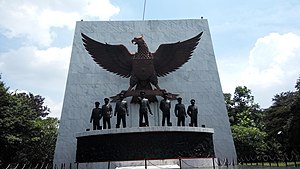Our website is made possible by displaying online advertisements to our visitors.
Please consider supporting us by disabling your ad blocker.
30 September Movement
| 30 September Movement | |||||||
|---|---|---|---|---|---|---|---|
| Part of the Cold War in Asia, Konfrontasi and Transition to the New Order | |||||||
 Pancasila Sakti Monument
Pancasila Sakti Monument    Victims found in Lubang Buaya. From left to right: General Ahmad Yani, Brigadier General D. I. Pandjaitan, Major General R. Suprapto. Brigadier General Sutoyo Siswomiharjo, Major General M. T. Haryono, Major General S. Parman, First Lieutenant Pierre Tendean. | |||||||
| |||||||
| Belligerents | |||||||
|
| ||||||
| Commanders and leaders | |||||||
|
Untung Syamsuri Mustafa Soepardjo D.N. Aidit Utomo Ramelan |
Suharto A.H. Nasution (WIA) Sarwo Edhie Wibowo Umar Wirahadikusumah | ||||||
| Casualties and losses | |||||||
| Six Indonesian Army commanders killed during the coup, along with other military and civilian casualties. | |||||||
| History of Indonesia |
|---|
 |
| Timeline |
|
|
| ||
|---|---|---|
|
Pre-independence Domestic policy Foreign policy Family Media and legacy Gallery: Picture, Sound, Video |
||
| ||
|---|---|---|
|
Pre-presidency Domestic policy Foreign policy Post-presidency Family
Gallery: Picture, Sound, Video |
||
The Thirtieth of September Movement (Indonesian: Gerakan 30 September, also known as G30S, and by the syllabic abbreviation Gestapu for Gerakan September Tiga Puluh, Thirtieth of September Movement, also unofficially called Gestok, for Gerakan Satu Oktober, or First of October Movement) was a self-proclaimed organization of Indonesian National Armed Forces members. In the early hours of 1 October 1965, they assassinated six Indonesian Army generals in an abortive coup d'état.[11] Later that morning, the organization declared that it was in control of media and communication outlets and had taken President Sukarno under its protection. By the end of the day, the coup attempt had failed in Jakarta. Meanwhile, in central Java there was an attempt to take control over an army division and several cities. By the time this rebellion was put down, two more senior officers were dead.
In the days and weeks that followed, the army, socio-political, and religious groups blamed the coup attempt on the Communist Party of Indonesia (PKI). Soon a mass purge was underway, which resulted in the imprisonment and deaths of many actual or suspected Communist Party members and sympathizers. Under the New Order and to this day, the movement is usually referred to as the Thirtieth of September Movement/PKI (Indonesian: Gerakan 30 September/PKI or "G30S/PKI") by those wanting to associate it with the PKI, and this term is also sometimes used by the current government.[12]

Investigations and questioning of Suharto's version of the events were long obstructed in Indonesia. While the Central Intelligence Agency (CIA) initially believed that Sukarno orchestrated all of it,[13] several outside sources found inconsistencies and holes in the army claims, notably Benedict Anderson and Ruth McVey who wrote the Cornell Paper that challenged it.[14][15]
- ^ Robinson, Geoffrey B. (2018). The Killing Season: A History of the Indonesian Massacres, 1965–66. Princeton University Press. ISBN 978-1-4008-8886-3.
- ^ Winarno, Hery H (21 June 2013). "De-Soekarnoisasi, Soeharto 'bunuh' Bung Karno di hati rakyat". merdeka.com (in Indonesian).
- ^ Feith, Herbert (October 1968). "Suharto's Search for a Political Format" (PDF). Indonesia. 6 (6): 88–105. doi:10.2307/3350713. hdl:1813/53447. JSTOR 3350713.
- ^ Lashmar, Paul; Oliver, James (1998). Britain's Secret Propaganda War: Foreign Office and the Cold War, 1948–77. Stroud, Gloucestershire: Sutton Pub. ISBN 0-7509-1668-0. OCLC 40876736. Retrieved 30 December 2021.
- ^ Lashmar, Paul; Oliver, James (1 December 1998). "How we destroyed Sukarno". The Independent. Archived from the original on 20 August 2013. Retrieved 30 December 2021.
- ^ Scott (1985) p. 243.
- ^ Kim, Jaechun (2002). "U.S. Covert Action in Indonesia in the 1960s: Assessing the Motives and Consequences". Journal of International and Area Studies. 9 (2): 63–85. ISSN 1226-8550. JSTOR 43107065.
- ^ Bevins, Vincent (2020). The Jakarta Method: Washington's Anticommunist Crusade and the Mass Murder Program that Shaped Our World. PublicAffairs. ISBN 978-1-5417-4240-6.
- ^ Crouch (2007) pp. 159, 205, 242
- ^ "G30S – Brigadir Jenderal Soepardjo Jenderal Angkatan Darat yang Terlibat dalam Peristiwa G30S".
- ^ "The assassination of generals on the morning of 1 October was not really a coup attempt against the government, but the event has been almost universally described as an 'abortive coup attempt,' so I have continued to use the term." Crouch 1978, p. 101.
- ^ Roosa (2006) p. 29.
- ^ THE LESSONS OF THE SEPTEMBER 30 AFFAIR Archived 26 November 2020 at the Wayback Machine, CIA Library
- ^ Anderson, Benedict R.; McVey, Ruth (1 June 1978). "What Happened in Indonesia?". New York Review of Books. ISSN 0028-7504.
- ^ Chan, Sewell (14 December 2015). "Benedict Anderson, Scholar Who Saw Nations as 'Imagined,' Dies at 79". The New York Times. ISSN 0362-4331. Retrieved 30 December 2021.
Previous Page Next Page









